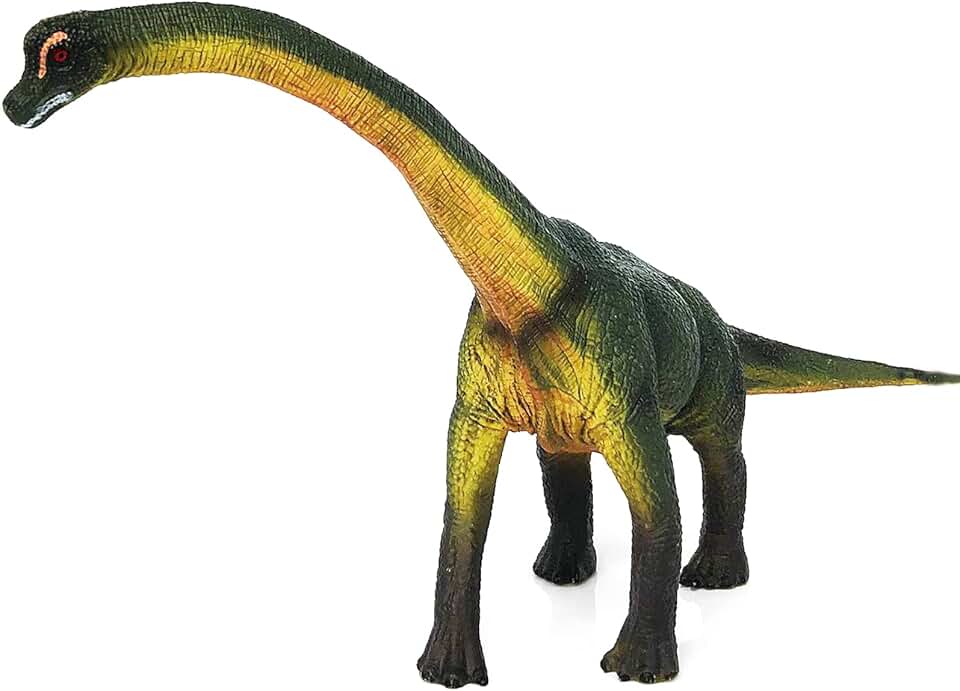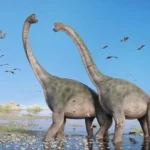Long-necked dinosaurs, or sauropods, are some of the most iconic and awe-inspiring creatures in the history of life on Earth. With their towering necks, enormous bodies, and sheer size, they appear invincible—yet, like any other group of animals, they were not without their natural predators. Despite their size and strength, these massive herbivores faced significant threats from carnivorous dinosaurs, particularly during the Jurassic and Cretaceous periods. In this article, we’ll explore the natural predators of long-necked dinosaurs and how they may have defended themselves against these threats.
The Vulnerability of the Long-Necked Giants
Sauropods, with their long necks, huge bodies, and slow movements, were not exactly built for rapid escapes or combat. Although they were equipped with powerful tails and could use their size as a deterrent, their vulnerable spots made them prime targets for carnivorous predators. The slow-moving nature of many sauropods, particularly the younger ones or smaller species, would have made them easier targets for large predators that could outmaneuver them.
However, size and strength were still among their most important defenses. The sheer scale of some sauropods, like Argentinosaurus, which could grow to over 100 feet in length, would have made it nearly impossible for most predators to take them down. But for the larger, more agile carnivores of the time, it was still possible to hunt sauropods, especially the younger, smaller, or sick members of the herd.
The Predators of Long-Necked Dinosaurs
1. Theropods: The Primary Carnivores
During the Jurassic and Cretaceous periods, theropods were the dominant carnivorous dinosaurs that posed the greatest threat to sauropods. These bipedal predators were equipped with sharp teeth, powerful jaws, and large claws, making them effective hunters of both large and small prey. Some of the most well-known theropods that likely hunted sauropods include:
- Allosaurus: One of the most well-known Jurassic predators, Allosaurus was a large theropod that could grow up to 30 feet long. It is believed that Allosaurus may have hunted in packs, which would have allowed them to take down larger prey like sauropods, especially young or injured individuals. Fossil evidence suggests that Allosaurus may have ambushed sauropods, attacking vulnerable parts of their bodies, such as their legs or necks.
- Tyrannosaurus rex: By the late Cretaceous period, the rise of the massive theropod Tyrannosaurus rex posed a significant threat to sauropods. T. rex was a top predator, growing up to 40 feet long and possessing powerful jaws capable of crushing bone. While T. rex primarily targeted smaller herbivores, it is likely that it would have gone after juvenile or weaker sauropods when given the opportunity. Though it is unlikely that T. rex would have attacked fully grown sauropods due to their size, it could have taken down younger or sick individuals.
- Spinosaurus: Known for its large sail and semi-aquatic lifestyle, Spinosaurus lived during the mid-Cretaceous period and may have been another potential predator of sauropods, particularly in areas where they lived near water. With its large size and powerful jaws, Spinosaurus could have taken on sauropod juveniles or any smaller or weaker individuals straying too close to the water.

2. Crocodile-Like Predators
Apart from theropods, large, crocodile-like predators were also present during the time of the sauropods. These reptiles, such as Deinosuchus, were massive and could reach lengths of over 30 feet. Though not technically dinosaurs, these enormous reptiles lived in the same ecosystems and were capable of attacking young sauropods near water sources. They would have likely ambushed vulnerable individuals that wandered too close to the water or got caught in mud traps, an environment where many juvenile sauropods could have been at risk.
How Did Sauropods Defend Themselves?
Despite the threat from predators, long-necked dinosaurs had several ways of defending themselves. Here are a few of the strategies that may have helped these massive herbivores survive in a world filled with dangerous carnivores:
1. Size and Physical Presence
The most obvious defense of long-necked dinosaurs was their sheer size. Many sauropods grew to lengths of 60 to over 100 feet, with some of the largest, like Argentinosaurus, weighing up to 80 tons. This size was a significant deterrent to most predators. For larger carnivores, attacking such a massive creature would have been risky and costly. Adult sauropods were too large for most theropods to take down, and their size likely made them hard to catch, especially for smaller predators.
2. Herd Behavior
Sauropods were not solitary animals; they often lived in large herds, which provided a collective defense against predators. Herds could protect the young or sick members, and when a threat was detected, the group could either flee or defend itself together. In many species of sauropods, adults likely took the role of protecting the vulnerable members of the herd, while the young stayed in the center of the group. This social structure would have increased their chances of survival, as predators would have had a much harder time isolating a single individual from the group.
3. Tail Defense
Many sauropods had long, muscular tails that could be used as a weapon to defend against predators. A well-timed strike with a tail could potentially injure or even kill a smaller carnivore, acting as a deterrent to any predator attempting to launch an attack. In fact, some species of sauropods, such as the Brachiosaurus and Diplodocus, were likely capable of swinging their tails with great force, using them as an effective defense against theropod predators.
4. Height Advantage
Sauropods, particularly those with long necks like the Brachiosaurus, were able to reach heights that allowed them to feed on vegetation that was inaccessible to most herbivores, providing them with a food source that few other animals could rival. This height also gave them a significant advantage when spotting predators from a distance. Their ability to see approaching threats from high up in trees or over large open areas would have provided them with valuable time to react.

Conclusion: A Constant Struggle for Survival
While long-necked dinosaurs were massive and had several strategies to protect themselves, they were not immune to the dangers of the prehistoric world. Carnivorous theropods like Allosaurus and Tyrannosaurus rex posed significant threats to juvenile and weaker sauropods, while crocodile-like predators could have targeted those near water. However, through their size, herd behavior, defensive tactics, and environmental adaptations, sauropods were able to survive and thrive for millions of years, leaving a lasting legacy in the fossil record. The struggle for survival between predators and prey was a fundamental aspect of the Mesozoic world, and the long-necked dinosaurs found ways to endure in the face of constant challenges.



